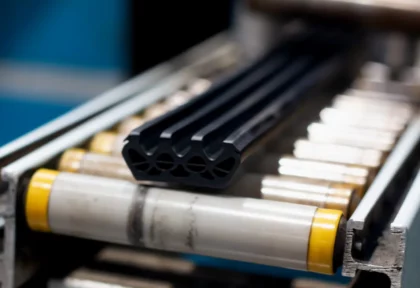Extrusion
At Protolis, we offer online extrusion molding services to produce your custom profiles for prototyping and low-volume production.
- 1 to 100+ meters or 500+ feet
- 20+ production materials
- Prototype extrusion tooling
- Ready within 3-5 weeks
- 10+ finishing options
What is extrusion molding?
Extrusion consists of shaping an aluminum alloy or plastic material into specific cross-sectional profile that meet your specifications. The material is inserted into a cylinder (matrix) and then pressed through an extrusion die to give it the desired shape.
At Protolis, you will work with experts to find the right fit for your project from a wide range of extrusion options, including materials and finishing.
What is extrusion molding?

Additional extrusion services
Our rapid production and prototyping extrusion capabilities are complemented by our other expertise, allowing us to meet a wide range of needs

Rapid tooling
Our cost-effective prototype dies enable production of profiles with less shape limitations and significantly reduce lead times.

Post-operation processing
We offer post-operation services such as CNC machining, as well as the addition of technical features like threading, to ensure the customization of your final extruded parts.

Assembly
Our experience enables the integration of your extrusion profiles with other parts, thereby facilitating the assembly of your final product.
Your project in 6 steps
Get your extrusion prototype or production profiles in no time. A flexible organization providing a personalized response to your need without any setback.
Your quote
Upload files and specifications
DFM
Design optimizations
Tooling
Sampling and adjustments
Production
Close follow-up
Quality control
Dimensional report, pictures, and videos
Delivery
Packing, door-to-door tracking
Applications
Extruded parts are used in many industries such as automotive (e.g. door seals, trim components), construction (e.g. window frames, pipes), electronics (e.g. heat sinks, LED housings), healthcare (e.g. tubing, catheters), and more, making them widely prevalent in our everyday surroundings.
Extrusion materials
We offer a wide range of materials for customizing your prototype and low-volume production profiles using extrusion technology. Below is a non-exhaustive list of commonly used materials for extrusion processes.
General extrusion characteristics
Extrusion finishes
There are many finishing options available for extrusion profiles. These mechanical or chemical processes improve the appearance, functionality, and durability of the parts.

Powder coating is similar to liquid spray paint, except that this process uses a dry powder. It improves the resistance to wear and corrosion. The resulting surface is uniform.

Brushing is a surface finishing method that forms continuous paralleled lines on the surface of metal parts. The purpose is usually to obtain a decorative effect with a slight level of reflection.

The type 2 and type 3 processes we provide are chemical (electrolyte) processes based on sulphuric acid that create an oxide layer. They protect parts from corrosion, increase their durability, and make the parts dielectric and non-conductive.
Extrusion capabilities
Protolis has strong partnerships for short-run custom extrusion services. Our dedicated team ensures that projects are meticulously handled, prioritizing both quality and timely delivery. For the post processing operation such as CNC and assembling, we will handle them in-house.
Extrusion FAQs
How long does it take to custom extrusion low-volume fabrication?
The time required for custom extrusion low-volume fabrication can vary depending on several factors, including the complexity of the design, the size, the quantity of parts needed, the availability of materials, and the specific capabilities of the extrusion facility. In general, custom extrusion projects with low-volume requirements can typically be completed within a few weeks (3 to 6 weeks). However, for more intricate designs or projects with unique specifications, the timeline may extend.
It’s advisable to discuss the specific details of your project with our specialists to get a more accurate estimate of the lead time for your custom extrusion fabrication.
What is the longest length of extruded part you can supply?
While there are no constraints on manufacturing capacity, it’s important to note that there are transportation limitations. For example, the maximum length for express freight is restricted to 2 meters, it becomes imperative to design and manufacture extruded profiles that adhere to this length restriction for efficient transportation.
What are the advantages and limitations of the extrusion process?
The extrusion process offers several advantages, including the ability to create complex cross-sectional profiles, material efficiency, and the capability to process a wide range of materials. However, it also has limitations such as high initial setup costs, which we have mitigated by developing prototype extrusion dies to reduce expenses. Additionally, extrusion is limited to continuous profiles, has the potential for surface defects, and faces constraints on the size and complexity of the cross-sections it can produce.
Related resources

Extrusion Guide

Racing car bodywork for one of the world’s premier auto shows











